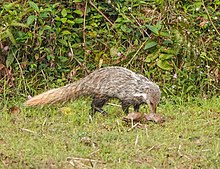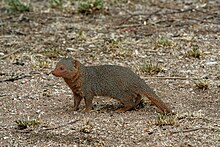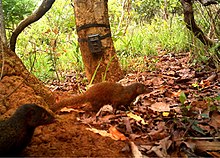
A | B | C | D | E | F | G | H | CH | I | J | K | L | M | N | O | P | Q | R | S | T | U | V | W | X | Y | Z | 0 | 1 | 2 | 3 | 4 | 5 | 6 | 7 | 8 | 9
| Mongoose | |
|---|---|

| |
| Top left: Meerkat Top right: Yellow mongoose Bottom left: Slender mongoose Bottom right: Indian gray mongoose | |
| Scientific classification | |
| Domain: | Eukaryota |
| Kingdom: | Animalia |
| Phylum: | Chordata |
| Class: | Mammalia |
| Order: | Carnivora |
| Suborder: | Feliformia |
| Superfamily: | Herpestoidea |
| Family: | Herpestidae Bonaparte, 1845 |
| Type genus | |
| Herpestes | |
| Genera[1] | |

| |
| Synonyms[1] | |
|
List
| |
A mongoose is a small terrestrial carnivorous mammal belonging to the family Herpestidae. This family is currently split into two subfamilies, the Herpestinae and the Mungotinae. The Herpestinae comprises 23 living species that are native to southern Europe, Africa and Asia, whereas the Mungotinae comprises 11 species native to Africa.[2] The Herpestidae originated about 21.8 ± 3.6 million years ago in the Early Miocene and genetically diverged into two main genetic lineages between 19.1 and 18.5 ± 3.5 million years ago.[3]
Etymology
The English word "mongoose" used to be spelled "mungoose" in the 18th and 19th centuries. The name is derived from names used in India for Herpestes species:[4][5][6][7] muṅgūs or maṅgūs in classical Hindi;[8] muṅgūs in Marathi;[9] mungisa in Telugu;[10] mungi, mungisi and munguli in Kannada.[11]
The form of the English name (since 1698) was altered to its "-goose" ending by folk etymology.[12] The plural form is "mongooses".[13]
Characteristics
Mongooses have long faces and bodies, small, rounded ears, short legs, and long, tapering tails. Most are brindled or grizzly; a few have strongly marked coats which bear a striking resemblance to mustelids. Their nonretractile claws are used primarily for digging. Mongooses, much like goats, have narrow, ovular pupils. Most species have a large anal scent gland, used for territorial marking and signaling reproductive status. The dental formula of mongooses is 3.1.3–4.1–23.1.3–4.1–2. They range from 24 to 58 cm (9.4 to 22.8 in) in head-to-body length, excluding the tail. In weight, they range from 320 g (11 oz) to 5 kg (11 lb).[14]
Mongooses are one of at least four known mammalian taxa with mutations in the nicotinic acetylcholine receptor that protect against snake venom.[15] Their modified receptors prevent the snake venom α-neurotoxin from binding. These represent four separate, independent mutations. In the mongoose, this change is effected, uniquely, by glycosylation.[16]
Taxonomy
Herpestina was a scientific name proposed by Charles Lucien Bonaparte in 1845 who considered the mongooses a subfamily of the Viverridae.[17] In 1864, John Edward Gray classified the mongooses into three subfamilies: Galidiinae, Herpestinae and Mungotinae.[18] This grouping was supported by Reginald Innes Pocock in 1919, who referred to the family as "Mungotidae".[19]
Genetic research based on nuclear and mitochondrial DNA analyses revealed that the Galidiinae are more closely related to Madagascar carnivores, including the fossa and Malagasy civet.[20][21] Galidiinae is presently considered a subfamily of Eupleridae.[22]
Phylogenetic relationships
Phylogenetic research of 18 mongoose species revealed that the solitary and social mongooses form different clades.[54] The phylogenetic relationships of Herpestidae are shown in the following cladogram:[55][3]














